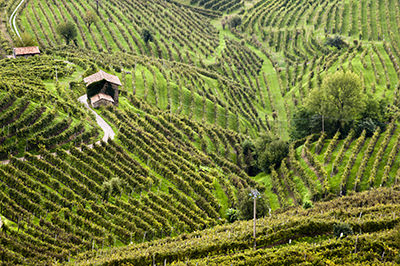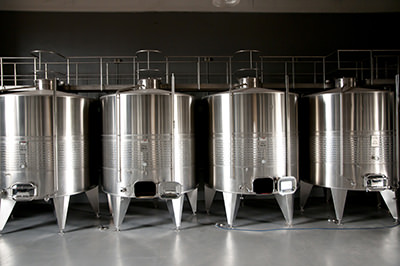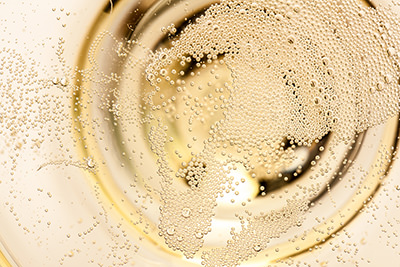
Let’s admit it. Prosecco is easy to take for granted. We buy it for a night out or in—easy drinking bubbles that give us a temporary and much-needed lift in general feelings of delight.
That’s all fine, but there’s more to know—and more to appreciate—about everyone’s favorite brunch go-to. For instance, its Ancient Roman roots, its potential connection to a long life, and its protracted, plucky rivalry with Big Bubbly, aka Champagne. So before any of us makes our next Bellini (with Prosecco, ahem), let’s take some time to get to know the bubbles in the bottle.
Yes, there is a town called Prosecco.
The delightful bubbly Prosecco we know and love today came from the village of Prosecco, a suburb of Trieste. The name “prosecco” is actually Slovenian, from prozek, or “path through the woods.” (Prior to being called Prosecco, the region was known as Puccino.) Today, Prosecco production extends beyond the small village, but this is where it all began.
Speaking of which, Prosecco has ancient history.
The Glera grape, which grew well in the Prosecco region and became the basis for Prosecco, was grown in Ancient Rome. In fact, in his Natural History, Pliny the Elder—who died in 79 AD—talks of Julia Augusta, “who gave the credit for her eighty-six years of life to the wine of Pizzino.” (In the Latin, on the opposite side, it actually says “Pucino vino,” as in Puccino, as in Prosecco.) So yeah, that’s major street cred.
As for street cred, Prosecco now has a DOC and a DOCG.
Since 2009, actually. The latter is slightly higher quality, or so it’s said, and much smaller than the DOC, comprised of 15 communes of vineyards, with vines growing in limestone-rich hillsides. The idea that it’s higher quality comes from the fact that, thanks to those steep hillsides, everything is done by hand. The DOC and DOCG are in Veneto and Friuli.
You probably don’t know the main Prosecco grape.
It’s not as famous as the Champagne grapes, or any of our favorite white varietals. It’s called “Glera,” and it’s the one that dates back to Roman times. Proseccco can also be made with Perera, Bianchetta, and Verdiso, and heavy hitters like Chardonnay, Pinot Gris, and Pinot Noir. But Glera’s the grandpapa of Prosecco.
And you might not know that Prosecco isn’t made in the Méthode Champenoise.
Well, one kind of Prosecco can be (the Conegliano Valdobbiadene in the DOCG). But the rest is made in the “charmat” method, AKA the “tank method,” where the fermented wine goes through its secondary fermentation in big steel tanks, rather than the bottle. Generally this means less contact with the “lees,” or yeast sediment, though a winemaker might introduce intentional contact to create a certain flavor profile.
Your wallet should be thankful for the Tank Method.
Because tank method secondary fermentation is so efficient, it means the product—Prosecco—is less expensive to make, and less expensive to purchase.
Your palate should be thankful for the Tank Method.
Just because it’s efficient doesn’t mean the Tank Method produces uncomplicated wines. Prosecco is made with highly aromatic grapes, and the “cleaner” tank method allows those aromatics to shine through—and literally bubble up—in the finished product.
The original Bellini recipe used Prosecco—not Champagne.
The Prosecco was born in 1948 at the famed Harry’s Bar in Venice, where some clever barman came up with a drink that would keep bridal shower’s socially manageable for decades to come: fresh white peaches pushed through sieve, the puree topped with crisp, bright Prosecco.
Not all Prosecco is bubbly.
Prosecco comes in three levels of “perlage,” basically a fancy word for delicious bubbles. There’s the most bubbly, spumante, the second-most, frizzante, and the entirely still (that’s right) tranquillo.
In fact, Prosecco didn’t bubble until the 19th Century.
The Romans may have loved it, and Italians continued to love it, but it wasn’t until Antonio Carpenè first subjected the still white wine to a second fermentation that Prosecco acquired it’s now lasting association with bubbles. The Carpenè Malvolti winery was the first to produce Prosecco as we know and guzzle it today.
Prosecco can thank The Recession for its victory over Champagne.
According to the Sparkling Wine Observatory (and yes, there is such a thing), Prosecco sold 307 million bottles to Champagne’s 304 in 2013. The likely cause for the victory is the affordability of quality Prosecco compared to the higher price point for decent entry-level Champagne. Not that Champagne is failing. It’s more that Prosecco’s price point works with the recent trend in “everyday” sparkling wine.



